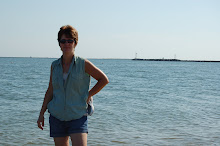Monday, December 24, 2012
The donkey lay suffering in silence, his leg broken. A brown cow stood nearby, one horn dangling, one ear askew. A lamb curled on the straw, missing an eye. One witness in the background had lost his head. From a veterinarian’s point of view, the situation was a real mess.
The donkey was the most critical patient; I stabilized his injured leg with a small piece of wood, although I thought an amputation was imminent. The cow’s horn hung by a thread, with no evident bleeding, so I simply snipped off the useless piece. I could probably reattach the ear at its base. The lamb’s missing eye could be replaced by a glass prosthetic . The plight of the headless bystander was obviously a job for a good surgical adhesive – once I located the head. It had probably become the puck in a game of cat hockey. I finally found it in the kitchen.
I assembled my instruments and fired up the glue gun. Time was of the essence; there were gifts to wrap and cookies in the oven. The end of a toothpick replaced the horn of the ox, and a dollop of hot glue returned its drooping ear to an anatomically correct position. I carefully amputated the donkey’s leg and carved a replacement from a tongue depressor. Having owned one-eyed cats and blind dogs, I knew the lamb would get along fine with his single eye. And although Balthazar will sport forever a collar of dried adhesive, his head settled nicely back on his shoulders.
Traditional holiday decoration here includes setting up the nativity scene on the dining room piano, marauding cats notwithstanding. Fresh hay is strewn across the wooden floor of the little stable. The figurines are placed in their time-honored positions: the Holy Family in the stable with the donkey and ox; the shepherd and his sheep just outside, and the richly clad Three Kings approaching with their gifts.
I’m not sure how old the crèche is , but Burk Family lore holds that the set predates my parents. I was taught about the Adoration of the Magi as a child, but enamored as I was even then of anything equine, what I really adored the idea of being born in a stable. I spent hours arranging the characters, which probably accounts for some of their current scars.
I imagine all that my little figures have witnessed as they looked out from their manger over the years: The sad Christmas Eve in 1942 when Dad’s civilian clothing returned from boot camp in a battered package, and one shoe fell out at Mom’s feet. The happy Christmas of 1945 with the card from Okinawa saying “I am coming home.” The Christmas when a month-old baby girl stared in fascination at the lights of the tree, and the one when she unwrapped a big package that held a saddle (of course I still have it!) . The holidays after the deaths of family members. Those when we knew someone’s passing was imminent. The awesome Christmas the astronauts sent a message from the moon. The subdued Christmas after 9-11 – and this year, another one overshadowed by sadness.
Some years it seems almost wrong to celebrate the holidays with mirth . It’s difficult to conjure up joy when incidents like the recent tragedy in Connecticut threaten to choke out merriment and warmth.
I replace my little figures in the stable and wonder what Mary knew as she held her newborn child. Was her joy tinged with sadness, knowing what lay ahead for her son? Yet the artist sculpted on her delicate face the soft smile of pure love.
The ancients anticipated the midwinter solstice with joy – celebrating even in the darkest of days the return of the light. Saint Francis of Assisi prayed “where there is hatred, let me sow love…where there is darkness, light; where there is sadness, joy.” In the 1500’s another Italian , Fra Giovanni, wrote “the gloom of the world is but a shadow; yet within our reach is joy.” A wise Native Americans said “to have joy, one must share it.” Maybe that’s our most human defense against the darkness –and maybe it’s the best.
Subscribe to:
Post Comments (Atom)



No comments:
Post a Comment